After all these years, the original NES Legend of Zelda title is still one of my top favorite games in the series. I think I only like Link's Awakening and Link to the Past more, making it third place. Not bad for the first in the series.
The Legend of Zelda Review Rewind
|
|
See PixlBit's Review Policies

On 12/15/2013 at 12:00 PM by Jamie Alston Remember kids, "Dodongo dislikes smoke". |

For anyone who enjoys a meaty 8-bit action/adventure romp.
With its deceptively easy gameplay and deep exploration, The Legend of Zelda represented a few first-time accomplishments for Nintendo, as well as the gaming industry itself. It was one of the first Famicom Disk Systems games to hit Japan in February of 1986, sporting the ability to save progress without needing a password. With its 1987 debut in America, it was released on a golden cartridge featuring a small backup battery to save progress -- making it the first game to use the technology. But most importantly, it was the first game to truly revolutionize the action/adventure genre with elements that similar games would borrow from for years to come.
Much like Mega Man 2 and Final Fantasy, this game has been reviewed, praised, and worshiped to death. If you pay a visit to sites with user reviews, you'd be hard-pressed to find a write-up that doesn't drool over the genre-defining legacy that Miyamoto's series undeniably established. But there was once a time when Miyamoto was not a name familiar to most NES owners -- despite having played his previous creations -- and The Legend of Zelda was just a game starring a kid wearing a funny green hat.
Our story begins in the kingdom of Hyrule, where Ganon has stolen the Triforce of Power and wants to plunge the world into darkness under his rule. Princess Zelda split the remaining Triforce of Wisdom into eight fragments and spread them throughout the land to prevent Ganon from getting his hands on it. In retaliation, he imprisoned her so she can no longer interfere with his plans. It’s up to Link to find the pieces of the Triforce of Wisdom, defeat Ganon, rescue Zelda, and restore peace to Hyrule.
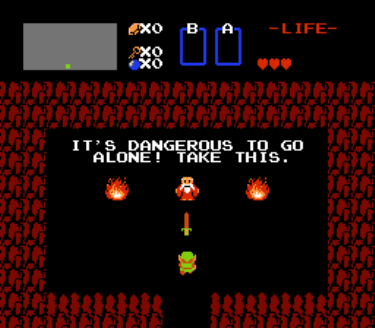
You’ll guide Link as he travels between the main overworld of Hyrule and nine dungeons that house the various pieces of the Triforce that he needs to collect. Above and below ground are filled with now-familiar enemies such as the rock-spitting Octoroks, spear-happy Moblins, shield-eating Like Likes (which nobody likes), and downright creepy Wallmasters all got their start here.
The game features a simple-but-effective fighting system. At all times, you have access to your sword and shield. When your health is at full strength, you can throw your sword across the screen, which is suitable for keeping your distance from the enemy. As you progress through the game, you’ll collect a plethora of secondary items -- many of which are invaluable additions to your arsenal. The boomerang is a perfect example: once obtained, you’ll have an easier time fighting multiple enemies because you can strategically stun (most of) them and then finish them off with your sword. Other items such as the bow and arrow, bombs, and many others remain relevant throughout the game. I was quite surprised by how integral the secondary items were to conquering the dungeons.
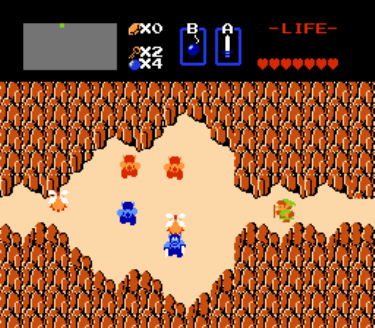
Link automatically has his shield at the ready when you're not attacking with the sword or certain other secondary items. Thankfully, it deflects objects like spears and stones -- the shield isn't just there as piece of Link's character sprite. Both the shield and the sword can be upgraded to better serve your offensive and defensive needs. The game offers you the flexibility to finish it without ever upgrading your equipment; however, it’s much more enjoyable once you find the various upgrades.
What I found interesting was the surprising sense of accomplishment that comes so early in the adventure. You feel like a winner with the now famous "item catch" fanfare that plays when doing simple things like obtaining Link's basic sword, getting the ladder, or collecting a letter to give to a certain old lady. Of course, that was nothing compared to the feeling that is conveyed upon finding a Triforce piece. In fact, when I played this for the first time 11 years ago, I remember thinking I won the game after finding the first Triforce piece. The Legend of Zelda definitely encourages the notion of savoring the victory.
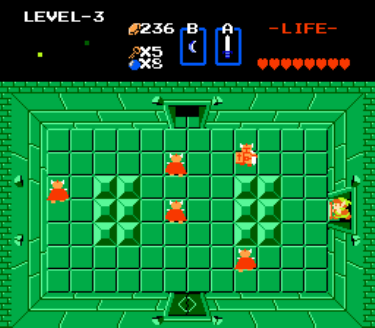
The nine dungeons are pretty well designed, with a compass and map hidden within each to guide you to the Triforce piece housed therein. Interestingly, these two helpful items don’t completely take the mystery out of exploring the dungeons. Certain doors are accessible only after all enemies in the current room are defeated, some stairways are hidden until you push a block in the correct direction to reveal that room's secret, and best of all, the enemies and bosses inhabiting the underworld sections often have unique weaknesses that need to be exploited in order to have the least amount of trouble getting past them. Even when you learn the weaknesses of your enemies, you still have to approach most of them with caution or you can find yourself in a perilous predicament very quickly. I still get a little nervous when I’m low on health and I have to fight a room full of Darknuts.
With all of the admirable qualities that can be found in the inaugural Zelda title, there is one aspect that didn't age quite as gracefully -- the non-linear approach. Actually, I should say that it was the execution of the non-linear approach. After all, it's great that you’re not forced to attack each dungeon in a super strict order and you are free to roam the land of Hyrule to your heart's content. But when it comes time to hunker down and finish the quest, things can come to a screeching halt once you realize that you don't know what the heck you’re supposed to do next.
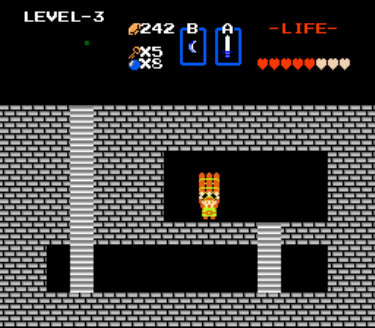
Sure, you will find occasional (and very cryptic) clues from creepy old people in caves and dark rooms. But am I really supposed to know that some guy telling me that "Spectacle Rock is an entrance to death" is creepy-old-man-speak for "place a bomb on one of the otherwise innocuous boulders somewhere at the top of the overworld map to access the final dungeon"? No way. You can expect to find stellar advice like that throughout the game. And while the difficulty may have been just right back when people cared if you beat a game on your own or not, it simply doesn’t matter much nowadays to the average player who is more interested in finishing the game than winning the admiration of his school buddies.
The visual style, while quite primitive by today's standards, was perfect for its time. The creatures that inhabit the land of Hyrule were quite unusual compared to the usual line-up found in most adventure games back then. In fact, it's almost puzzling as to how some of these character types could have even been imagined, but that’s what makes them so interesting in the first place. I had never known of any other game (at the time) that had characters quite as unusual as the floating Peahat or the odd-looking Pols Voice. Exploring the overworld and underworld areas is quite enjoyable with the smooth scrolling from screen to screen. I also liked the way Link was engulfed in a black backdrop every time he found one of the Triforce fragments. It really amplifies the feeling of a job well done each time you complete a dungeon.
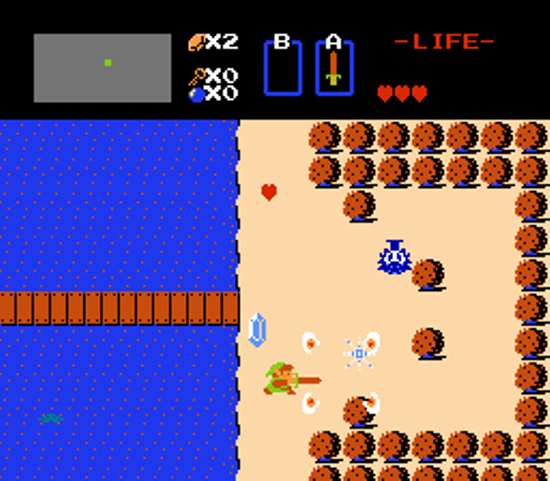
To say the audio in the game was "good" would be a bit of an understatement. What's ironic is that there isn't much variety in the way of multiple musical scores. There are really only two main pieces of music that play throughout the majority of the game: the overworld and dungeon themes. However, these tunes are pretty catchy and prove to be the perfect accompaniment to the action going on. In fact, the music for the overworld sections has become a ubiquitous feature throughout the life the Zelda series. The sound effects are also quite memorable as well, especially the whistle, whose ditty later made its way into Super Mario Bros. 3.
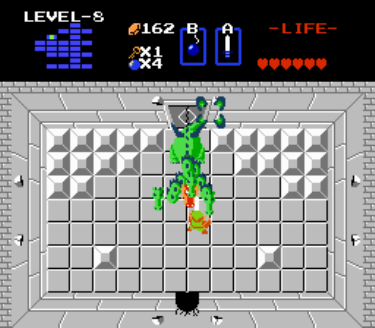
The Legend of Zelda has become a well-respected, venerable series and for good reason. This first game of many really solidified the action/adventure genre and provided an unforgettable experience for anyone willing to devote their time to explore the land of Hyrule. There were no menu commands to sort through, and no level-up system to dictate the growth of your character. Instead, the game featured the simple use of a sword and shield and left it up to you as to how you would develop Link. Just keep in mind that the game will not hold your hand with regard to where to go or how exactly to accomplish certain key objectives. So don't be ashamed to whip out the strategy guide if need be. It's a great buy for anyone interested in familiarizing themselves with the series' humble beginnings.










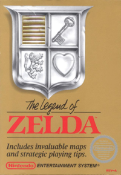

Comments